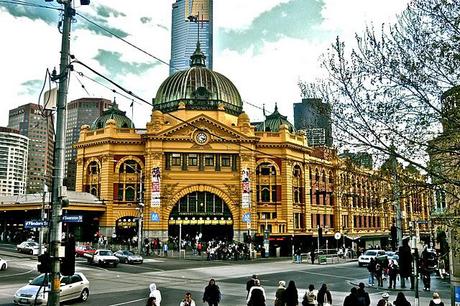
Flinders Street Station, 2010 (my own photo)
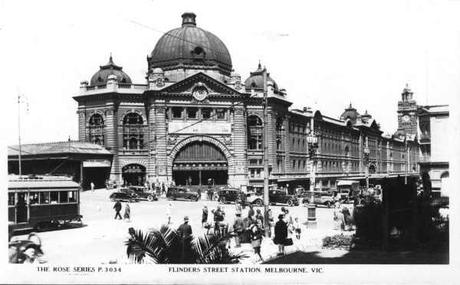
Flinders Street Station, ca. 1934 (State Library of Victoria Picture Collection)
The Melbourne TerminusTrainshave been arriving at the site of Flinders Street Station long before theconstruction of the iconic building we recognise today. In 1854, the MelbourneTerminus was the first city railway station built in Australia and was situated on the corner of Flinders and Elizabeth Streets. Originally, it comprised onlyone weatherboard building and a small platform. This serviced the first railwayline in Victoria, running only to Sandridge (Port Melbourne). A number of additionswere made to the terminus over the following years, including the introductionof a St Kilda line in 1857 and extra platforms from 1877 onwards. Nonetheless,the collection of low timber and brick buildings with simple corrugatediron roofs was a far-cry from the grand station that stands today!
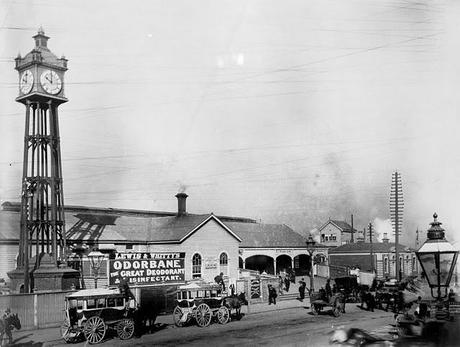
Elizabeth Street entrance to Melbourne Terminus on Flinders Street, 1880 (State Library of Victoria)

Commuters leaving platform on ramps ca. 1890 (The Age)
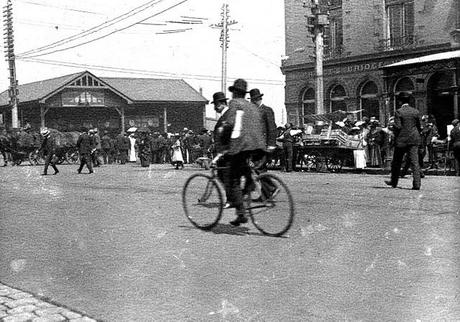
Swanston Street/Flinders Street entrance (now the main entrance with dome) ca. 1900-1905. NB: The Princes Bridge Hotel on the right-hand side still exists, although it is now known as the Young & Jackson Pub.
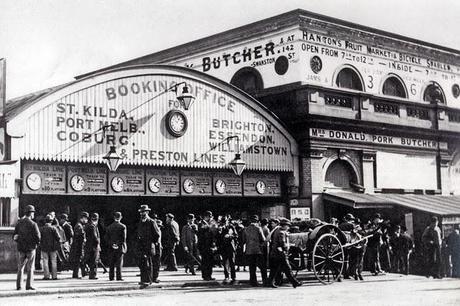
The Melbourne Terminus ca. 1890-1900
Melbourne Boom TimeIn the 1880s, Melbourneenjoyed a boom-time following the Victorian gold rush. The city became largerthan most European capitals, the population doubled in a decade, and a fortune was poured into the construction of impressive buildings that rivalledthose of New York, Chicago and London. This era also saw the suburban railwaynetwork expand significantly. According to Jenny Davies, author of Beyondthe Facade, the Melbourne Terminus was deemed “an eyesore, inefficient anduneconomical” and a new station was proposed.The CompetitionIn 1889, a worldwide competition was held for thedesign of the new station. In May 1900, the first prize was awarded to twoVictorian Railways employees, Fawcett and Ashworth, for their design entitled Green Light. As you can see below, the plans differ slightly from the currentFlinders Street Station: a fourth storey and basement were added; and thebeautifully ornate Art Nouveau arched iron roof on the Swanston Streetconcourse was never built (due to expense). While the station is mostfrequently labelled as Edwardian Baroque, Fawcett and Ashworth described theirdesign as being influenced by the “French Renaissance” style. The Frenchinfluence is most apparent in the symmetrical composition of the main FlindersStreet block, the use of giant order, heavily rusticated piers, squat domes andbroad arches. This aesthetic was combined with architectural features familiarin Melbourne at the time, including the red brick and golden-cream contrast,the use of banking, and the grouping of windows vertically under tallarches.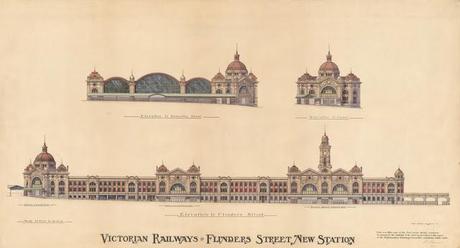
Fawcett and Ashworth's design (SLV)
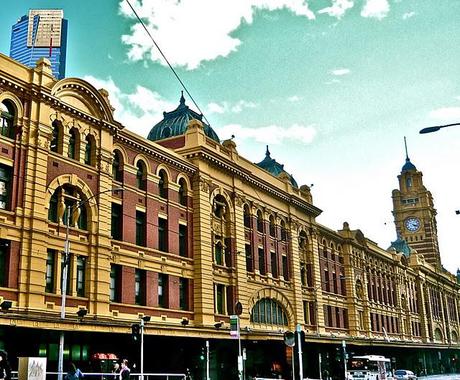
Flinders Street facade, 2010 (my own photo)
A Melbourne Icon is BornFlinders Street Station was officially opened to thepublic in 1910. By this stage, the railway lines reached Werribee, Rockbank,Diggers Rest, Craigieburn, South Yan Yean, Eltham, Croydon, Bayswater,Dandenong, Aspendale and Sandringham. At the time of opening, it was rumouredto be the busiest passenger station in the world! By the 1930s, Flinders StreetStation had on average 241,130 passengers per week, putting it well-ahead ofany other station in the world, including Gare Saint-Lazare, Paris (150,000passengers) and Grand Central Station, New York (108,843 passengers).

Flinders Street/Swanston Street entrance, ca. 1900-1914 (SLV)
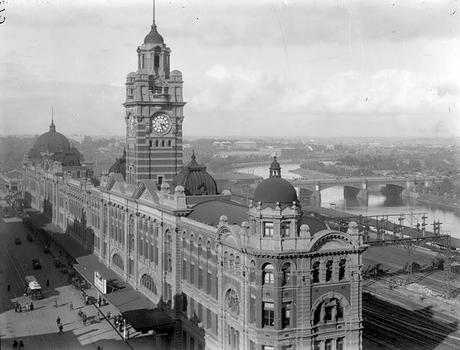
Elevated view of Flinders Street facade looking east, 1916 (SLV)
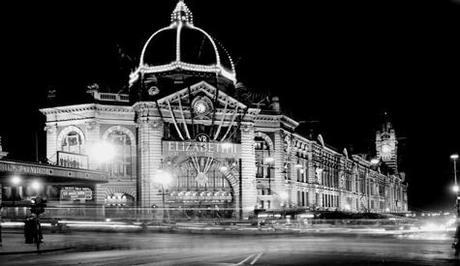
Illuminated to celebrate the coronation of Queen Elizabeth, 1953 (SLV)
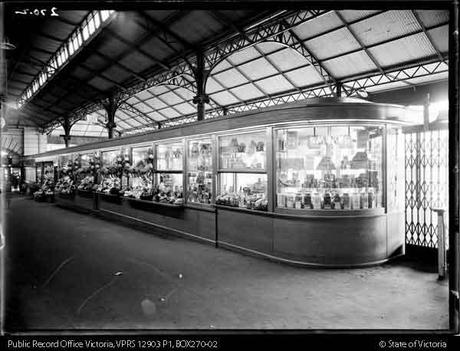
Swanston Street concourse (PRO Vic)

Bookstall (PRO Vic)
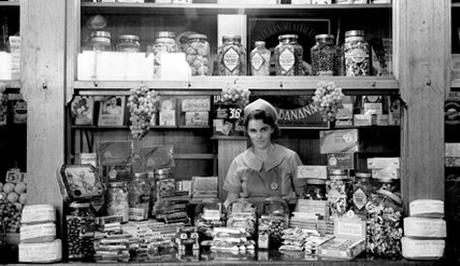
Woman serving at a kiosk in the station (PRO Vic)
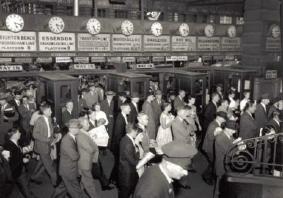
Peak hour under the clocks. Clocks have been a feature of the station from the 1860s, leading to the Melbourne idiom "I'll meet you under the clocks." Originally, a railway officer manually operated the clocks, using a long pole to change them 900 times on average during an eight hour day. In 1983, there was public outcry after the clocks were replaced by digital indicators of train departure times. The original clocks were promptly reinstalled in one day! (PRO Vic)
The Victorian Railways InstituteThe Victorian Railways Institute officiallyopened in 1910 and its offices were located inside the brand-new FlindersStreet Station. The organisation was created for the “self-betterment” ofrailway employees. It hoped to increase staff morale and workplace stability inorder to reduce the likelihood of industrial upheaval - of particular concernafter the 1903 rail strikes. The result was extraordinary! The instituteprovided lectures ranging from the technical (bookkeeping and accountancy), tothe philosophical (“Nietzsche and the Present German Spirit” in WWI), to thebizarre (“Reminiscences of an Army Surgeon in the Turko-Servian and Turko-Russian Wars of 1876-78”)! The station housed the Institute’s clubroomsfor a broad range of clubs, including debating, fencing, wine appreciation,poetry, cat lovers, and even “rose devotees”! The Institute also createdsome amazing facilities, including a beautiful ballroom, gymnasium,billiards room, lecture theatre, library and even a childcare nursery!The BallroomTheBallroom still exists on the third floor of the station. The beautiful vaulted,pressed metal ceiling spans the full width of the building and the room canseat 400 people. In 1918, the ballroom held dance classes, ballroomcompetitions and socials every Wednesday night. By 1934, it was usedpractically six nights per week and was one of the most popular dancehalls inMelbourne. During WWII, many dances were held for Allied servicemen on leave.The Victorian Railways Institute decided to close the ballroom (as it was inneed of repair) and the last dance was held on 10 September in 1983.
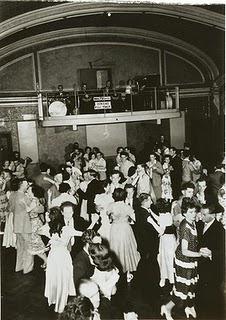
Ballroom in the 1950s (The Age)
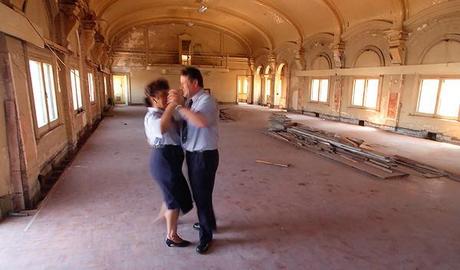
The (now derelict) ballroom in 1996 (Andrew de la Rue, The Age)
The manner in which the ballroom has been left todeteriorate is appalling. Without any preservation measures in place, the room is at risk of deteriorating beyond repair through sheer neglect. The integral structure of the room is intact and, if repaired/preserved, there are many brilliant ways it could be used today: a beautiful restaurant; art gallery; museum about the history of the station or city; or a boutique shop! The ballroom is integral to Melbourne's character and history. It is a travesty that (a) it has been neglected for so long, and (b) it is not accessible to the people of Melbourne.The GymnasiumTheVictorian Railways Institute also provided a gymnasium (in the traditionalsense) for its employees!In addition to the gymnasium, the flat rooftopof the station was used frequently as a 440-yard running track!Apparently it was not uncommon to see people running on the roof of the stationfrom across the river at Southbank!
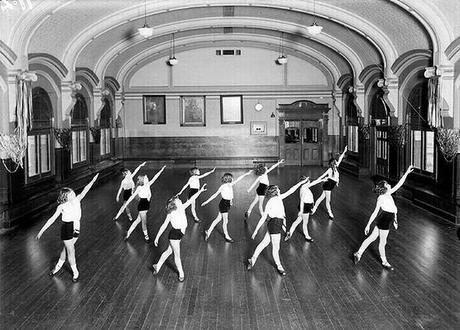
Gymnasium (The Age)
The NurseryTheInstitute also provided a childcare facility for the use of rail travellers. When the nursery was opened in 1933, there were onlythree of its kind in the world (the other two being in Paris and Chicago). Thisservice was often used by mothers coming from suburban train stations to the city who would leave their small children in care as they wentabout their day in town. An outbreak of Polio in 1937 led to the temporary closureof the nursery for one year (at this time, children did not even attend primaryschool, lest the disease spread, and classes were transmitted by radio to children's homes!) The nursery was permanently closed in 1942, allegedlybecause of war precautions. Regrettably, much of the nursery was demolished inthe 1980s during renovations - yet another travesty!
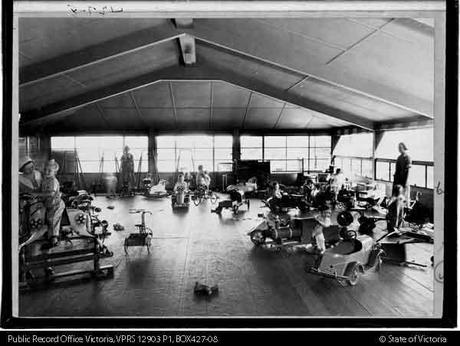
Second floor childcare nursery (PRO Vic)

Rooftop playground, opened in 1936 (PRO Vic)
Degraves Street SubwayWhile the idea of a subway to decrease congestion had been bandied about since 1929, Campbell Arcade (or the Degraves Street Subway as it is now known) was officially approved in 1950. The Campbell Arcade entrance was opened in November 1954 and is now famous for its Art Deco pink ceramic tiled walls and black marble columns. The arcade still contains a number of shops (which are quite cute and quirky!) and exhibits artwork in glass boxes.
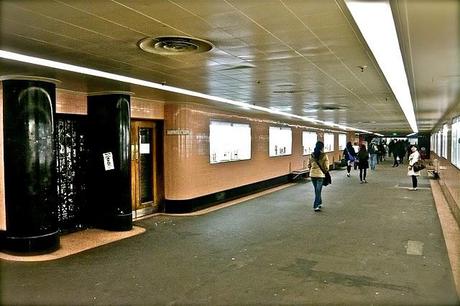
Campbell Arcade, 2010 (my own photo)
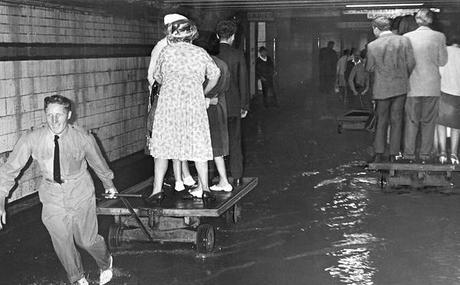
Innovation in the face of a subway flood, 1965 (The Age)
Demolition Attempts and RenovationsTherehave been numerous attempts to demolish Flinders Street Station, particularlyduring the 1960s and 70s. The fact that we have come so close to completely losingFlinders Street Station makes the mind boggle. It also reinforces the need forus to remain on our toes in the present day about other buildings thatdevelopers/governments tell us ought to be 'upgraded.' There are many ways topreserve historic buildings while increasing their functionality in a modern city. As a reaction to a 1974 plan to redevelop the site,Bill Howie of Radio 3AK said, "by all means, let's have a modern,progressive Melbourne... but in our haste let's not ignore the features thatgive the city its own special charm, for if we do, we will create for ourselvesa soulless exercise in concrete and steel that may please the planners but dovery little for those who work and live here." These sentiments ringjust as true today!
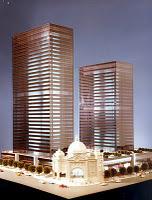
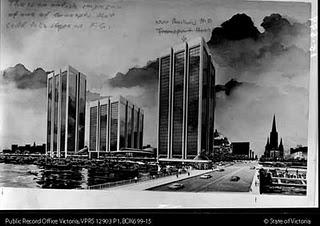
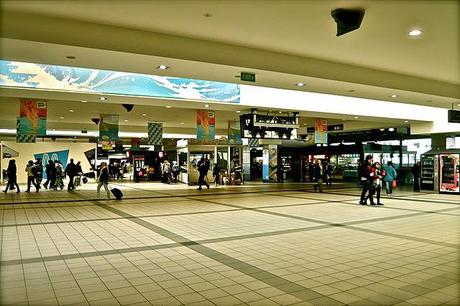
Characterless Swanston Street concourse, 2010 ("modern shopping centre") (my own photo)
As Jenny Davies notes in Beyond the Facade,"if the budget had been $50 million in 1982, Flinders Street Station couldhave been restored to its turn of the century glory." Instead, only $7 million was allocated to the project and the developers decided to completely ignore heritagesuggestions! Renovations of the great stations of Paris, New York and Washington demonstrate that it is possible to preserve old-world charm and grandeur of historical buildings while allowing for functionality and progression. Why we continue to denigrate our city's heritage for the sake of a myopic view of progression is beyond belief! For More Information I could not hope to cover every aspect of thehistory of Flinders Street Station in this post. If your interest has been piqued, I recommend having aread of Jenny Davies' excellent book called Beyond the Facade: Flinders Street, More Than Just a Railway Station. The detrimental renovations of the station and the appalling neglect of the ballroom are devastating. Hopefully we can learn from these mistakes and take action now! There are urgent threats facing other heritage buildings as we speak and we must act now if we are not to fall into the same traps!Click here for an eye-opening article on this topic by Rupert Mann, President of Melbourne Heritage Action, in The Age. Thank you to those who requested the feature on Flinders Street Station. The next time I am catching the train, the fascinating history and old images of the station will now definitely be in my mind!References:Backhouse, Megan, 'Dance hall days' in The Age (February 2, 2008) Davies, Jenny, Beyond the Facade: Flinders Street, More Than Just a Railway Station (2008) Department of Transport Website: http://www.transport.vic.gov.au/DOI/Internet/transport.nsf/AllDocs/60FC28D7E8B7CB46CA2576A8001AFA38?OpenDocumentFiddian, Marc, Flinders Street Station: Melbourne's Taj Mahal (2003) Mann, Rupert, 'Demolition job on city heritage' in The Age (September 13, 2010)Millar, Royce and Silkstone, Dan, 'Push to reawaken city's sleeping beauty' in The Age (May 23, 2005) Museum Victoria Website: http://museumvictoria.com.au/marvellous/powered/flindersst.aspNational Trust Website: http://www.nattrust.com.au/campaigns/flinders_street_station Otto, Kristin, Capital: Melbourne When It Was the Capital City of Australia 1901-27 (2009) pp 332-7Scott-Norman, Fiona, 'The beauty of gothic decay' in The Age (January 25, 2008) Stephens, Andrew, 'Where the city finds its way' in The Age (July 24, 2010) Victorian Heritage Database: http://vhd.heritage.vic.gov.au/places/heritage/64960
